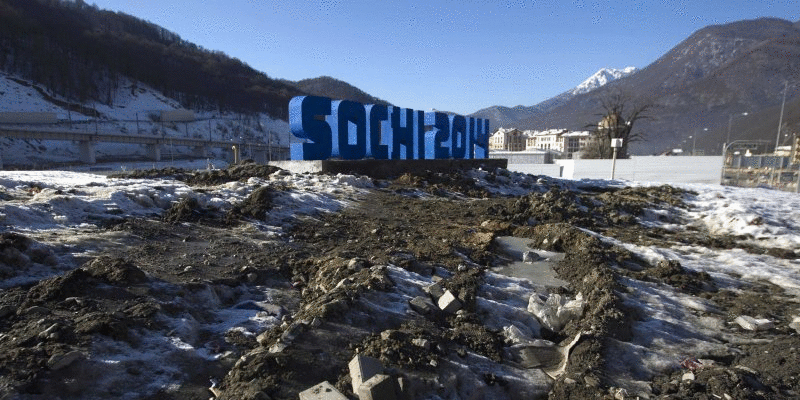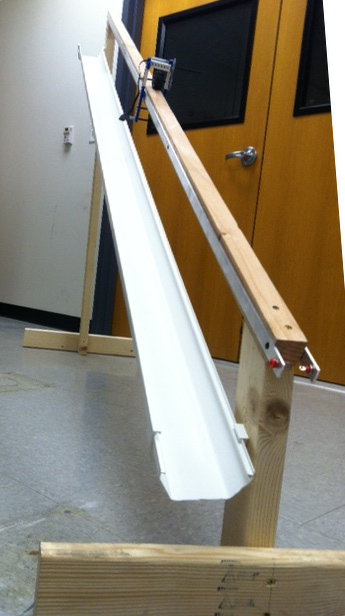Links: ME112Notes, Crawlers2014, Crawler Notes, QandACrawlerFinePoints
Running Cool at Sochi in 2014
5Feb - Final updates!
On this page... (hide)
- 1. Deliverables
- 2. Design Requirements
- 2.1 The track
- 2.2 The Lego kits and motor
- 3. Assessment
- 4. Design Tips
It's almost time for the 2014 Sochi Winter Olympics and Vladimir Putin has pulled out all the stops to make it a spectacular event. Every contingency is being considered, from security to "plus temperature snow making". Above all, every event should run professionally and without glitches.
For example, consider the bobsled event. What Vladimir wants to see is a smooth-running event -- not, ahem, "cool runnings". And, having discovered that the Jamaican team is back for 2104, Vlad has hastily funded a spinoff from Qbotix (a Silicon Valley startup with some former ME112ers) to make a version of their monorail for rescuing any stuck bobsleds.
You are that spinoff! This is your chance to show what your little robot design consultancy can do. As a first step, Vlad asks for a 1/12 scale prototype to prove that your concept will work. The timetable is urgent: the prototype has to be working by February 10.
1. Deliverables
1.1 Team Formation (by midnight on the day of your lab Jan 24th or Jan 27th)
Enter your team on the Crawler Team Signup page. We want to meet with all team members at design reviews, so we need all team members to be in the same lab session. As a reminder, you can find who is in your lab session on the LabSections page and we can help form teams.

Failure is not an option
1.2 Concept Design Reviews (Jan 31, Feb 3 during lab sessions)
We will meet with each team to assess initial progress. At this review we expect:
- that you have listed your team on the Crawler Team Wiki, with a team photo, names, and an email link.
- you have one or more hardware prototypes using the Lego kits.
- some evidence that alternative concepts have been explored (a logbook with sketches of alternatives would satisfy us in this regard).
- some preliminary analysis in a form that can be turned in. The analysis should include:
- a free body diagram of one of the designs with approximate quantitative estimates of the important force and torque magnitudes. (A digital scale will be available in MERL 133 to help get weights and forces.)
- a preliminary transmission ratio (motor revolutions per crawler distance traveled) and some evidence to support this choice.
- a plan for how to measure the efficiency of (i) your motor, (ii) your Lego transmission, (iii) your crawler propulsion on the rail.
Here is the Design Review Scoring Sheet that we will use and hand back to you for feedback.
1.3 Initial Tests (Wed Feb 5 in class)
Demonstrations and power measurements will be conducted in class following the guest lecture. Teams are invited to try their designs. We'll start in the main classroom and move to MERL 133.
1.4 Final Demonstrations (Feb 7,10)
We will test your crawler according to the Design Requirements and performance objectives below.
- NEW: We have decided to combine the final demonstrations into 2 big sessions starting at 12:35 on Friday and Monday. It should be fun (and a bit more chaotic) with a larger group of teams looking on. Everybody is welcome to observe the teams on either day. We'll have a signup board, and any teams with special time constraints should let us know if they want to go early or late.
- We will measure times and currents per the performance objectives below and we'll try to keep an updated spreadsheet with computed results for those who are feeling competitive.
- Everybody gets 1 trial initially. If there is a glitch, you can certainly try again (even Vlad understands these are early prototypes), but you need to get back in the queue so that others are not held up.
- Given the revised format of this event we will NOT be asking for documentation of efficiency, etc. Save it for your report!
As noted in email and in class -- if your Friday or Monday has a conflict that makes it hard to attend for at least part of the 12:35-2:00 session on your respective day, please let us know and we'll see what we can work out.
1.5 Design Documentation (Fri, Feb 14)
A design document shall be delivered that documents
- the design specifications
- the rationale behind your team’s prototype
- the results of testing
- recommendations for future development.
Updated: Details on the document format and guidelines on content are posted in the Crawlers/Documentation folder on Courswork, along with a couple of samples of work from previous years. During the week of Feb 10-14 staff will be available for reviewing draft document sections during office hours.
2. Design Requirements
To get a wide range of initial concepts, we ask each team to design and test an original bobsled retrieval prototype from a provided Lego kit and electric motor. The prototype should be able to encounter the bobsled 1/2 way up the test channel and continue to the top. Then it should return back down, with bobsled. The bobsled proxy will have a mass of approximately 200 grams and will be equipped with a magnet for easy attachment to your device.
In addition to the bobsled, each team must carry up a 200 gram rescue team mass (onboard the Crawler at all times) to model the weight of a rescue personnel and supplies.
- The device must operate with a power supply provided in MERL 133. The operating voltage will be 6V and the maximum current is approximately 2 Amps. In contrast to previous years, we will not have long "extension cord" wires trailing from the devices. Instead we have provided two powered rails from which current and voltage can be measured.
- At the top of the track you have two options:
- You can ask us to reverse the power leads, sending your crawler briskly down
- You ask us to simply detach the power leads and, if your crawler supports it, you can coast down. This would require that your transmission is "back drivable." Note that your design will actually coast more easily with leads unplugged than with them connected or shorted. Why is that?
- Because the final version will be solar powered, the prototype should try to minimize energy consumption.
- The device can only be constructed from materials provided in the kit, with the following exceptions:
- rubber bands and small springs
- string or thread
- tape or glue
- lubricants (be careful not to use petroleum based lubricants, they can melt the lego pieces)
- paper clips, wire and nylon cable tie wraps (“zip ties”)
- cardboard or foam core
- metal stock for attracting the magnetic bobsled (but not to be used for structural support).
If in doubt about any items, contact the ME112 teaching team in advance! Specifically, no additional Lego parts, motors or 3rd party transmission elements or RC car parts are permitted. Also, no lasercut parts (save the PRL Lasercamm for the final project!). The one possible exception to this rule might be if you want to improvise something to hold your "brushes" for getting power off the rail and you've already done everything else.
2.1 The track
Our initial proxy is an approximately 2m long miniature bobsled channel with powered monorail perched above. The track is inclined at an angle of 30 degrees. You need to get your bobsled up to the black tape line (approximately 1 foot down from the end of the rail) that marks the top of the chute.
2.2 The Lego kits and motor
Lego kits will be available from the TAs as soon as any teams are formed. The kit cost is $30 per person, payable in cash or check to Stanford University (write "ME112 lab" on the "memo" line).
3. Assessment
Each team's effort will be evaluated as follows:
- Initial design review (20%)
- Crawler performance (40%) (See performance objectives below.)
- Final document (40%)
3.1 Performance Objectives
- crawler capable of ascending- 10
- crawler capable of picking up mass- 8
- crawler can continue ascending carrying mass- 15
- crawler capable of descending (with mass) having reached the top- 5
- energy efficiency- 12
- For every 2J below 32J of energy dissipation [per meter traveled], 1 point is awarded, up to a max of 12 points. In other words, 0 points are awarded for 32J of energy dissipation and 12 points are awarded for 8J.
Details of testing: We will measure three times and associated current consumptions:
- t1, i1 during 0.5 meters of typical climbing sans bobsled
- t2, i2 during 0.5 meters of typical climbing with bobsled
- t3, i3 during 1.85 meters of typical descent with bobsled
We then compute Joules/meter using a length-weighted average of the measured values. In other words, 25% from t1,i1 (adjusted for 1 meter), 25% from t2,i2 (adjusted for 1 meter) and 50% from t3,i3 (adjusted for 1 meter).
4. Design Tips
Take some time to discuss team roles and responsibilities. With 3-4 people, you should do some parallel-tasking so that each person really does 1/4 or 1/3 of the total effort. Think about how to hand-off work and materials between people on the team. You may want to set up a box in MERL for your team.
- You can also use the Crawler Team Wiki to share your documents and results or link from your team photo there to Googledocs, etc.
- If your Lego skills are rusty, spend some time trying to build a couple of example vehicles. Take time to learn about the possible gear center distances and their relationships to Lego spacings. (See CrawlerNotes for links to tips on how to build good transmissions:)
- Don’t make last-minute design modifications before testing. This has resulted in spectacular disasters in the past!
- The Lego kits will limit your design options somewhat. Nonetheless, they allow to experiment with various geometries and transmissions. Consider spur gears, right-angle gears, worm gears, etc.
- Lego assemblies are also good for visualizing the three-dimensional force balances on gears and shafts.
- The lab space in MERL 133 will house the power supplie(s), shafts, wires and testing equipment. Please keep all materials in this room. You should have access at all hours with your I.D. card. If anything seems missing or broken please email the staff right away. The sooner we know, the sooner we can fix it.
- Periodically check out the Crawler Notes and QandACrawlerFinePoints




